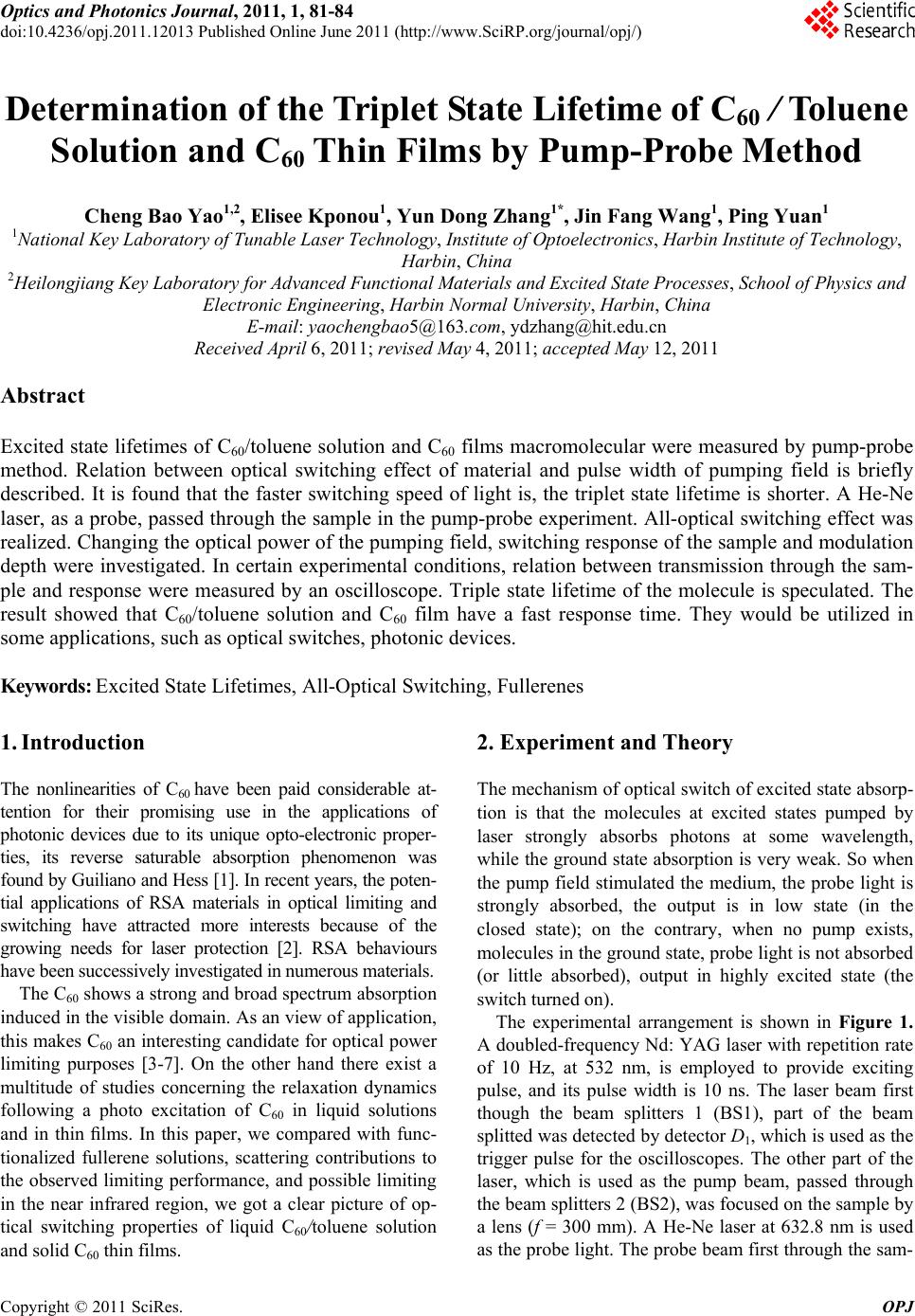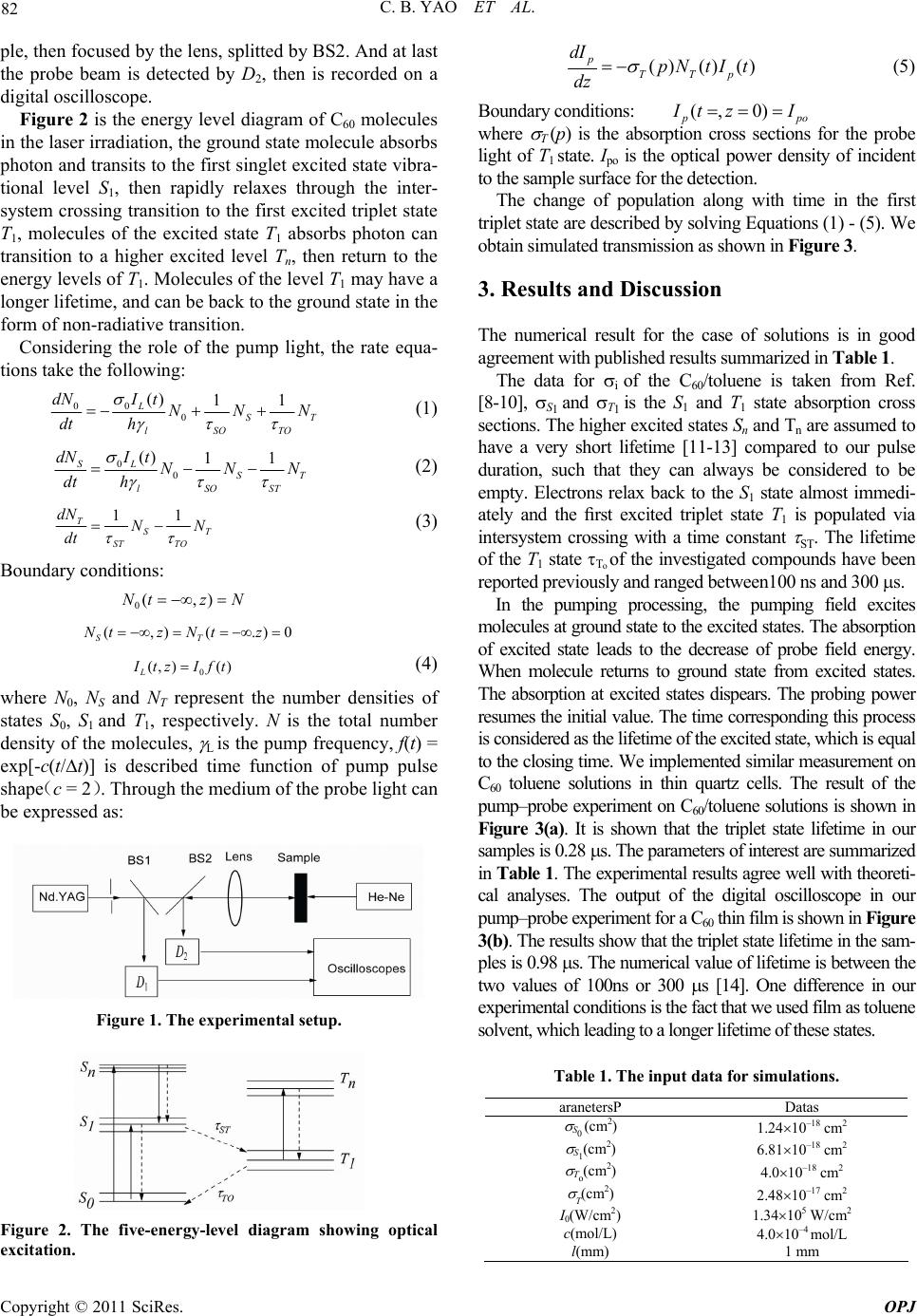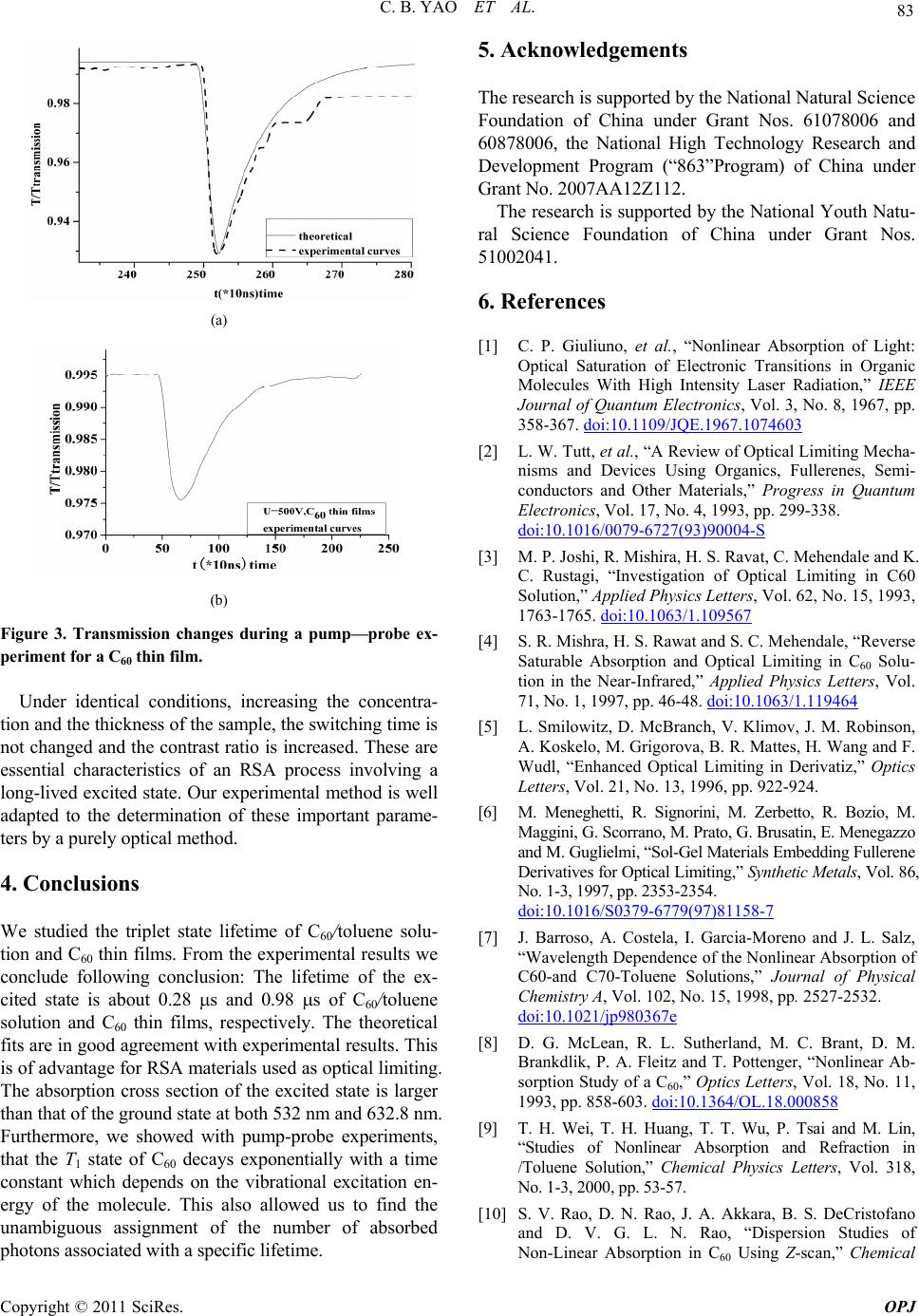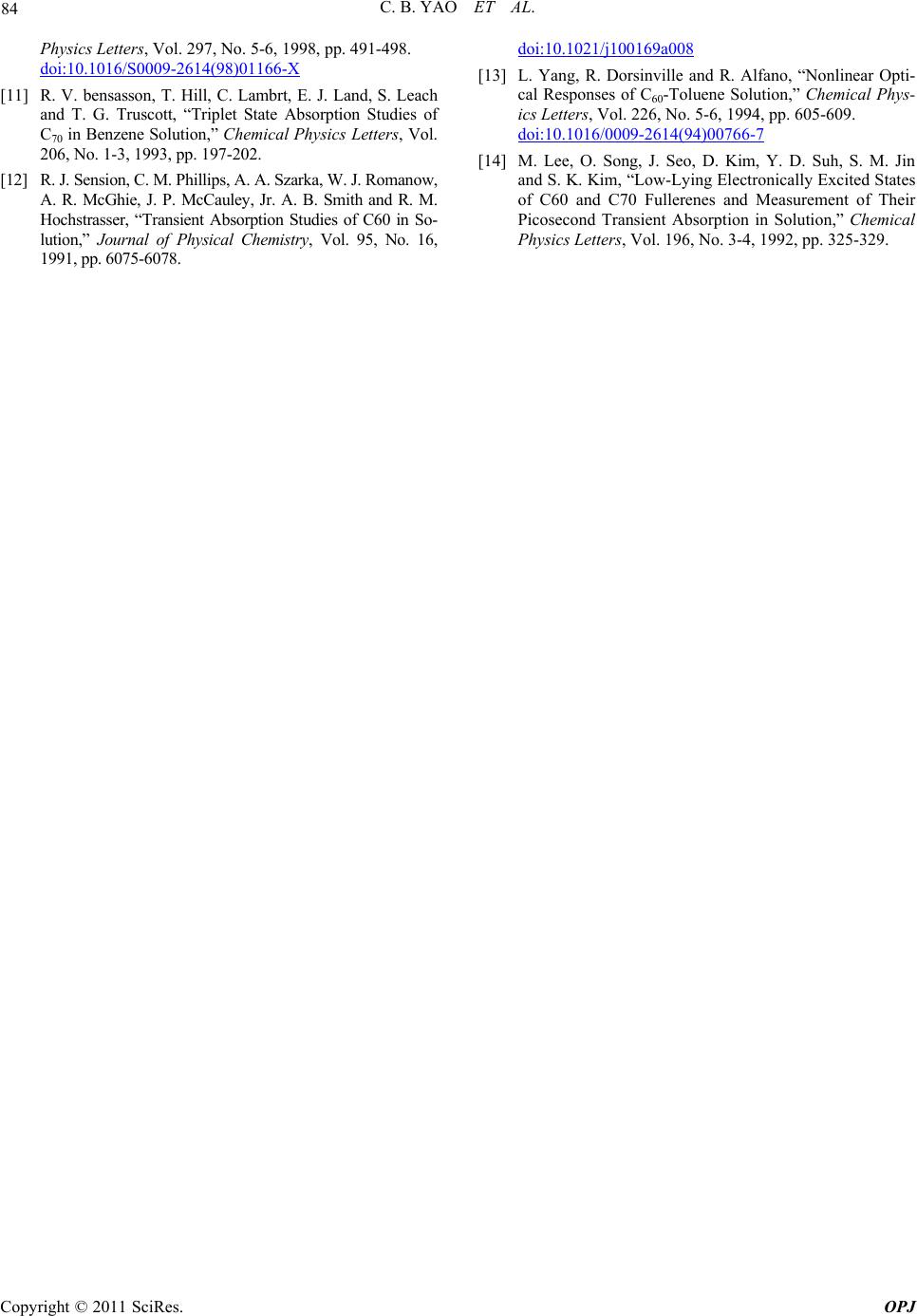Paper Menu >>
Journal Menu >>
 Optics and Photonics Journal, 2011, 1, 81-84 doi:10.4236/opj.2011.12013 Published Online June 2011 (http://www.SciRP.org/journal/opj/) Copyright © 2011 SciRes. OPJ Determination of the Triplet State Lifetime of C60 / Toluene Solution and C60 Thin Films by Pump-Probe Method Cheng Bao Yao1,2, Elisee Kponou1, Yun Dong Zhang1*, Jin Fang Wang1, Ping Yuan1 1National Key La boratory of Tunable Laser Te ch nology, Institute of Optoelectronics, Harbin Institute of Techn ology, Harbin, China 2Heilongjiang Key Laboratory for Advanced Functional Materials and Excited State Processes, School o f P hys i c s an d Electronic Engineering, Harbin Normal University, Harbin, China E-mail: yaochengbao5@163.com, ydzhang@hit.edu.cn Received April 6, 2011; revised May 4, 2011; accepted May 12, 2011 Abstract Excited state lifetimes of C60/toluene solution and C60 films macromolecular were measured by pump-probe method. Relation between optical switching effect of material and pulse width of pumping field is briefly described. It is found that the faster switching speed of light is, the triplet state lifetime is shorter. A He-Ne laser, as a probe, passed through the sample in the pump-probe experiment. All-optical switching effect was realized. Changing the optical power of the pumping field, switching response of the sample and modulation depth were investigated. In certain experimental conditions, relation between transmission through the sam- ple and response were measured by an oscilloscope. Triple state lifetime of the molecule is speculated. The result showed that C60/toluene solution and C60 film have a fast response time. They would be utilized in some applications, such as optical switches, photonic devices. Keywords: Excited State Lifetimes, All-Optical Switching, Fullerenes 1. Introduction The nonlinearities of C60 have been paid considerable at- tention for their promising use in the applications of photonic devices due to its unique opto-electronic proper- ties, its reverse saturable absorption phenomenon was found by Guiliano and Hess [1]. In recent years, the poten- tial applications of RSA materials in optical limiting and switching have attracted more interests because of the growing needs for laser protection [2]. RSA behaviours have been successively investigated in numerous materials. The C60 shows a strong and broad spectrum absorption induced in the visible domain. As an view of application, this makes C60 an interesting candidate for optical power limiting purposes [3-7]. On the other hand there exist a multitude of studies concerning the relaxation dynamics following a photo excitation of C60 in liquid solutions and in thin films. In this paper, we compared with func- tionalized fullerene solutions, scattering contributions to the observed limiting performance, and possible limiting in the near infrared region, we got a clear picture of op- tical switching properties of liquid C60/toluene solution and solid C60 thin films. 2. Experiment and Theory The mechanism of optical switch of excited state absorp- tion is that the molecules at excited states pumped by laser strongly absorbs photons at some wavelength, while the ground state absorption is very weak. So when the pump field stimulated the medium, the probe light is strongly absorbed, the output is in low state (in the closed state); on the contrary, when no pump exists, molecules in the ground state, prob e light is not absorb ed (or little absorbed), output in highly excited state (the switch turned on). The experimental arrangement is shown in Figure 1. A doubled-frequency Nd : YAG laser with repetition rate of 10 Hz, at 532 nm, is employed to provide exciting pulse, and its pulse width is 10 ns. The laser beam first though the beam splitters 1 (BS1), part of the beam splitted was detected by detector D1, which is used as the trigger pulse for the oscilloscopes. The other part of the laser, which is used as the pump beam, passed through the beam splitters 2 (BS2), was focused on the sample by a lens (f = 300 mm). A He-Ne laser at 632.8 nm is used as the probe light. The probe beam first through the sam-  C. B. YAO ET AL. Copyright © 2011 SciRes. OPJ 82 ple, then focu sed by the lens, splitted by BS2. And at last the probe beam is detected by D2, then is recorded on a digital oscilloscope. Figure 2 is the energy level diagram of C60 molecules in the laser irradiation, the ground state molecu le absorbs photon and transits to the first singlet excited state vibra- tional level S1, then rapidly relaxes through the inter- system crossing transition to the first excited triplet state T1, molecules of the excited state T1 absorbs photon can transition to a higher excited level Tn, then return to the energy levels of T1. Molecules of the level T1 may have a longer lifetime, an d can be back to the gr ound state in the form of non-radiative transition. Considering the role of the pump light, the rate equa- tions take th e following: 00 0 () 11 LST lSOTO dNI t N NN dt h (1) 00 () 11 SL ST lSOST dNI t N NN dt h (2) 11 TST ST TO dN NN dt (3) Boundary conditions: 0(,) N tzN (,)(.)0 ST Ntz Ntz 0 (, )() L ItzIft (4) where N0, NS and NT represent the number densities of states S0, S1 and T1, respectively. N is the total number density of the molecules, L is the pump frequency, f(t) = exp[-c(t/t)] is described time function of pump pulse shape(c = 2). Through the medium of the probe light can be expressed as: Figure 1. The experimental setup. Figure 2. The five-energy-level diagram showing optical excitation. ( )()() pTTp dI pN tIt dz (5) Boundary conditions: (, 0) p po I tz I where T (p) is the absorption cross sections for the probe light of T1 state . Ipo is the optical power density of incident to the sample s urface for t he detection. The change of population along with time in the first triplet state are described by solving Equations (1) - (5). We obtain simulated transmission as shown in Figure 3. 3. Results and Discussion The numerical result for the case of solutions is in good agreement with published resul ts summarized i n Table 1. The data for i of the C60/toluene is taken from Ref. [8-10], S1 and T1 is the S1 and T1 state absorption cross sections. Th e higher ex cited states Sn and Tn are assumed to have a very short lifetime [11-13] compared to our pulse duration, such that they can always be considered to be empty. Electrons relax back to the S1 state almost immedi- ately and the first excited triplet state T1 is populated via intersystem crossing with a time constant ST. The lifetime of the T1 state To of the investigated compounds have been reported previously and ranged between100 ns and 300 s. In the pumping processing, the pumping field excites molecules at ground state to the excited states. The absorption of excited state leads to the decrease of probe field energy. When molecule returns to ground state from excited states. The absorption at excited states dispears. The probing power resumes the initial valu e. The time correspondin g this process is considered as the lifetime of the excited state, which is equal to the closing time. W e implemented similar measuremen t on C60 toluene solutions in thin quartz cells. The result of the pump–probe experiment on C60/toluene solu tions is shown in Figure 3(a). It is shown that the triplet state lifetime in our samples is 0.28 s. The parameters of interest are summarized in Table 1. The experimental results ag ree well with theoreti- cal analyses. The output of the digital oscilloscope in our pump–probe e xperime nt for a C 60 thin film is shown in Figure 3(b). The results show that the triplet state lifetime in the sam- ples is 0.98 s. The numerical value of lifetime is between the two values of 100ns or 300 s [14]. One difference in our experiment al conditions is t he fact that we used film as toluene solvent, which leading to a longer lifetime of these states. Table 1. The input data for simulations. aranetersP Datas S0 (cm2) 1.2410–18 cm2 S1(cm2) 6.8110–18 cm2 To(cm2) 4.010–18 cm2 T(cm2) 2.4810–17 cm2 I0(W/cm2) 1.34105 W/cm2 c(mol/L) 4.010–4 mol/L l(mm) 1 mm  C. B. YAO ET AL. Copyright © 2011 SciRes. OPJ 83 (a) (b) Figure 3. Transmission changes during a pump—probe ex- periment for a C60 thin film. Under identical conditions, increasing the concentra- tion and the th ickness o f the sa mple, the switch ing ti me is not changed and the contrast ratio is increased. These are essential characteristics of an RSA process involving a long-lived excited state. Our experimental method is well adapted to the determination of these important parame- ters by a purely opti cal method. 4. Conclusions We studied the triplet state lifetime of C60/toluene solu- tion and C60 thin films. From the experimental results we conclude following conclusion: The lifetime of the ex- cited state is about 0.28 s and 0.98 s of C60/toluene solution and C60 thin films, respectively. The theoretical fits are in good agreement with experimental results. This is of advantage for RSA materials used as optical limiting. The absorption cross section of the excited state is larger than that of the ground state at both 532 nm and 632.8 nm. Furthermore, we showed with pump-probe experiments, that the T1 state of C60 decays exponentially with a time constant which depends on the vibrational excitation en- ergy of the molecule. This also allowed us to find the unambiguous assignment of the number of absorbed photons associated with a specific lifetime. 5. Acknowledgements The research is supported by the National Natural Science Foundation of China under Grant Nos. 61078006 and 60878006, the National High Technology Research and Development Program (“863”Program) of China under Grant No. 200 7AA 12Z112. The research is supported by the National You th Natu- ral Science Foundation of China under Grant Nos. 51002041. 6. References [1] C. P. Giuliuno, et al., “Nonlinear Absorption of Light: Optical Saturation of Electronic Transitions in Organic Molecules With High Intensity Laser Radiation,” IEEE Journal of Quantum Electronics, Vol. 3, No. 8, 1967, pp. 358-367. doi:10.1109/JQE.1967.1074603 [2] L. W. Tutt, et al., “A Review of Optical Limiting Mecha- nisms and Devices Using Organics, Fullerenes, Semi- conductors and Other Materials,” Progress in Quantum Electronics, Vol. 17, No. 4, 1993, pp. 299-338. doi:10.1016/0079-6727(93)90004-S [3] M. P. Joshi, R. Mishira, H. S. Ravat, C. Me henda le and K. C. Rustagi, “Investigation of Optical Limiting in C60 Solution,” Applied Physics Letters, Vol. 62, No. 15, 1993, 1763-1765. doi:10.1063/1.109567 [4] S. R. Mishra, H. S. Rawat and S. C. Mehendale, “Reverse Saturable Absorption and Optical Limiting in C60 Solu- tion in the Near-Infrared,” Applied Physics Letters, Vol. 71, No. 1, 1997, pp. 46-48. doi:10.1063/1.119464 [5] L. Smilowitz, D. McBranch, V. Klimov, J. M. Robinson, A. Koskelo, M. Grigorova, B. R. Mattes, H. Wang and F. Wudl, “Enhanced Optical Limiting in Derivatiz,” Optics Letters, Vol. 21, No. 13, 1996, pp. 922-924. [6] M. Meneghetti, R. Signorini, M. Zerbetto, R. Bozio, M. Maggini, G. Scorrano, M. Prato, G. Brusatin, E. Menegazzo and M. Guglielmi, “Sol-Gel Materials Embedding Fullere ne Derivatives for Optical Limiting,” Synt hetic Metal s, Vol. 86, No. 1-3, 1997, pp. 2353-2354. doi:10.1016/S0379-6779(97)81158-7 [7] J. Barroso, A. Costela, I. Garcia-Moreno and J. L. Salz, “Wavelength Dependence of the Nonlinear Absorption of C60-and C70-Toluene Solutions,” Journal of Physical Chemistry A, Vol. 102, No. 15, 1998, pp. 2527-2532. doi:10.1021/jp980367e [8] D. G. McLean, R. L. Sutherland, M. C. Brant, D. M. Brankdlik, P. A. Fleitz and T. Pottenger, “Nonlinear Ab- sorption Study of a C60,” Optics Letters, Vol. 18, No. 11, 1993, pp. 858-603. doi:10.1364/OL.18.000858 [9] T. H. Wei, T. H. Huang, T. T. Wu, P. Tsai and M. Lin, “Studies of Nonlinear Absorption and Refraction in /Toluene Solution,” Chemical Physics Letters, Vol. 318, No. 1-3, 2000, pp. 53-57. [10] S. V. Rao, D. N. Rao, J. A. Akkara, B. S. DeCristofano and D. V. G. L. N. Rao, “Dispersion Studies of Non-Linear Absorption in C60 Using Z-scan,” Chemical  C. B. YAO ET AL. Copyright © 2011 SciRes. OPJ 84 Physics Letters, Vol. 297, No. 5-6, 1998, pp. 491-498. doi:10.1016/S0009-2614(98)01166-X [11] R. V. bensasson, T. Hill, C. Lambrt, E. J. Land, S. Leach and T. G. Truscott, “Triplet State Absorption Studies of C70 in Benzene Solution,” Chemical Physics Letters, Vol. 206, No. 1-3, 1993, pp. 197-202. [12] R. J. Sension, C. M . P h il lip s , A . A . S z ar ka , W . J . Rom a now , A. R. McGhie, J. P. McCauley, Jr. A. B. Smith and R. M. Hochstrasser, “Transient Absorption Studies of C60 in So- lution,” Journal of Physical Chemistry, Vol. 95, No. 16, 1991, pp. 6075-6078. doi:10.1021/j100169a008 [13] L. Yang, R. Dorsinville and R. Alfano, “Nonlinear Opti- cal Responses of C60-Toluene Solution,” Chemical Phys- ics Letters, Vol. 226, No. 5-6, 1994, pp. 605-609. doi:10.1016/0009-2614(94)00766-7 [14] M. Lee, O. Song, J. Seo, D. Kim, Y. D. Suh, S. M. Jin and S. K. Kim, “Low-Lying Electronically Excited States of C60 and C70 Fullerenes and Measurement of Their Picosecond Transient Absorption in Solution,” Chemical Physics Letters, Vol. 196, No. 3-4, 1992, pp. 325-329. |

